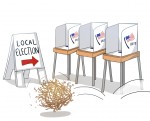What were you doing on Nov. 3? I’m going to take a wild guess and say you were not in a voting booth casting a vote for the local Los Angeles County elections. But don’t worry, you’re not alone in your inaction.
According to the Los Angeles County Registrar-Recorder/County Clerk website, in Los Angeles County, 1,603,211 people were registered to vote. The number that actually made it to the polls on Tuesday? Only 145,640, or 9 percent of the total registered voting population in Los Angeles.
And while this is to be expected, as off-year elections and local elections traditionally experience the lowest level of voter turnout, this is not a reason to accept the results with apathy and move on.
Action must be taken to ensure that these same abysmal rates do not continue each year there is an off-year or local election. Students can play a critical role in reversing this trend by engaging and voting in elections.
According to a report released by the Knight Foundation in June 2015, “young people vote at lower rates in local elections than any other age group,” meaning we are very much part of the easily fixable problem of low voter turnout. Recognizing that our age demographic is failing in this regard is the first step to fixing the problem.
While individuals have a variety of reasons for not voting, none of them hold much merit. Some may believe local elections are pointless because the stakes are much lower than a presidential election, but that mindset is dangerous. In an article published in Political Research Quarterly from March 2014, the authors discuss the danger of low voter turnout in local, off-year elections. With an incredibly small percentage of people voting, small factions can end up determining where public funding goes, which can have serious, lasting effects on a community.
Looking at the voter turnout rate from the Los Angeles County elections that took place this Tuesday, the same problem arose: A ridiculously small percentage of the population was able to control important policy choices.
A prime example of this from the Tuesday election is the Compton Unified School District S Measure, which passed Tuesday night with 55.83 percent of the vote, or 2,163 votes, will bring the district $350,000,000 in bonds to “reconstruct local schools and facilities, including research libraries, modern classrooms and science labs, media and performing arts centers, technology centers and athletic complexes; improve safety, security, roofing, plumbing, heating, electrical and other systems.”
Ballotpedia reports that the Compton District serves almost 25,000 students, almost the size of the UCLA undergraduate population, meaning this measure affects many individuals. And yet only 3,874 people voted on the measure Tuesday night.
This almost insignificant number of individuals became incredibly significant on Tuesday, as their votes were able to decide the fate of the controversial measure. Many who opposed the funding efforts believe money should be spent on getting more teachers and paying teachers better instead of improving and developing facilities.
So coming back to UCLA students, you might be wondering why we should care what happens to the Compton Unified School District, or other local issues that were voted on in the most recent November elections. Local elections matter because as the Knight Foundation report puts it, local elections are the ones “that have the most immediate impact on our lives.” The Knight Foundation goes on to cite the White House, which reports that the majority of Americans interact with their local governments more than the federal government on a daily basis.
Thinking about turnout rate for the Los Angeles elections in contrast to elections at UCLA, it’s abysmal. This past spring, for the Undergraduate Students Association Council elections, the voter turnout rate was 29.6 percent, with a little more than 8,000 undergraduate students voting for candidates and a referendum to raise money for student groups.
Though the elections are obviously very different, many can agree that 30 percent is not a turnout rate to boast about, especially when voting in USAC elections involves filling out an online form on MyUCLA. Despite how ridiculously easy it is to vote, more than 70 percent of students don’t, meaning they have forsaken their ability to have a say in where their fees are going or which campus initiatives are being supported with their money.
Now think about that concept on a bigger scale: In the most recent elections in Los Angeles County, several thousand voters were able to make decisions about who they elected into mayoral positions, and whether or not certain schools would receive funding. Voting allowed small groups of individuals to shape policy, in turn shaping various Los Angeles communities, showing how powerful a single vote can be.
Getting in the habit of voting and being civically engaged, whether it be for USAC elections, local elections or presidential elections, will allow our generation to mobilize.
It’s critical for us as UCLA students to play a role in ensuring that we are engaged citizens in our communities. Even if Los Angeles is not your home, register to vote in the city you are from. Make sure you are playing an active role in your community, wherever it is, by casting a vote in local elections.
